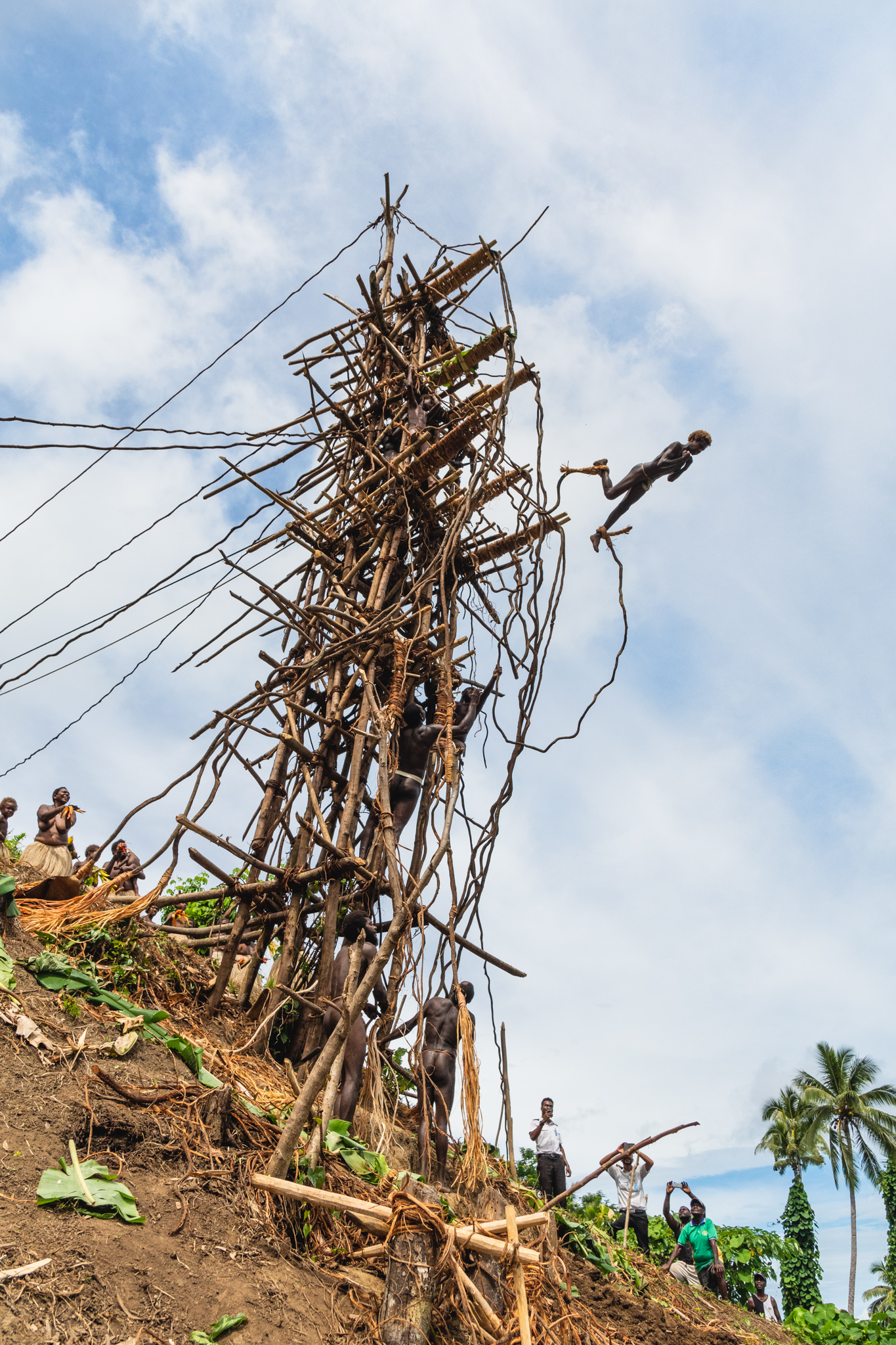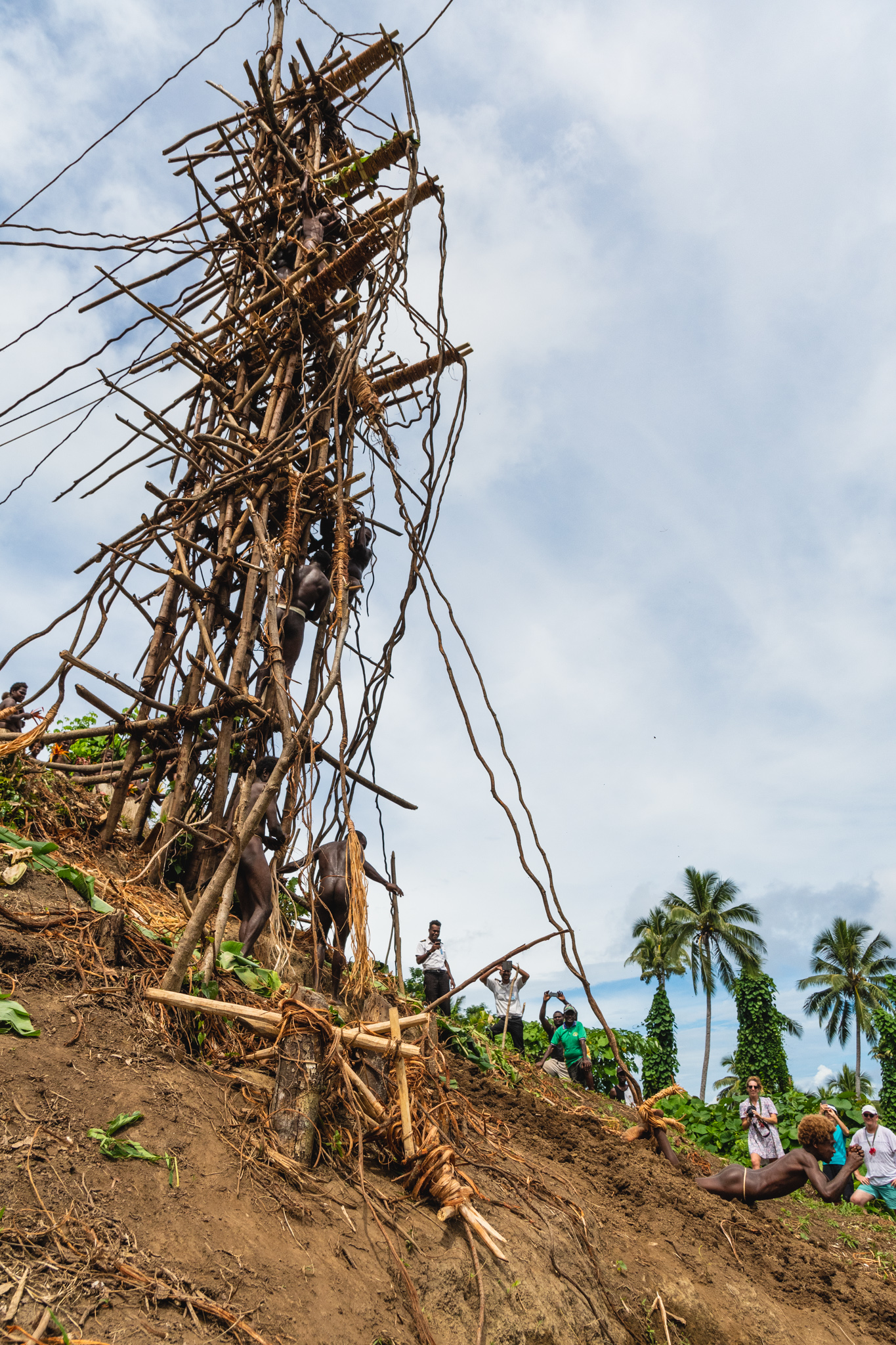The Nagol (land diving) of southern Pentecost Island, Vanuatu is arguably the most extreme ritual performed by any known culture today. Each year, the local men construct towers up to 16 metres in height for the sole purpose of jumping off them. With vines lashed tightly around their ankles, they leap off the towers and plummet head first towards the ground. During the fall, their bodies experience the most g-force out of anyone in the non-industrialised world. But why do they risk their lives each year to perform these death-defying leaps? It all started with the legend of a chase.
The chase
The Nagol legend tells of a kind and hard working woman named Melu, who was married to a lazy, ungrateful and ill-tempered man named Tamalie. After a long day working in the fields, Melu returned home to prepare her husband's evening meal. After presenting the meal to her husband however, the ever ungrateful Tamalie shouted at her, demanding that she prepare more food for his friends. Melu refused and shouted back. This uncharacteristic act of defiance infuriated Tamalie who grabbed a large stick and begun advancing towards her. Melu fled and ran into the jungle with Tamalie following in vengeful pursuit.
Soon Melu was lost in the dense undergrowth of the jungle. She could not see Tamalie but she could hear his angry rustling getting louder; he was gaining on her. Melu reached a clearing in the jungle and found herself at the base of a large Banyan tree. Realising she could not outrun her husband, she climbed the tree in an attempt to hide from him. Tamalie burst into the clearing and searched for Melu. Unable to find her at ground level, he glanced up and spotted her trying to hide in the tree. The very sight of her renewed his rage and he begun to claw his way up the tree towards her. Melu climbed higher until she reached the end of the tallest branch. It was the end of the line. With nowhere to go and her furious husband closing in, she devised a desperate plan and frantically started lashing a pair of vines around her ankles. Tamalie clambered onto the final branch and raced towards Melu, who at the very last moment, threw herself off the branch. Tamalie, completely caught by surprise, lost his footing and fell.
Melu, bruised and dazed, found herself hanging upside-down, suspended above the ground. She untangled herself from the vines and cautiously approached Tamalie who was face down in the mud. He was dead.
The wailing spirit
In celebration of this legend, the women of southern Pentecost island begun jumping off the Banyan trees with vines wrapped around their ankles, paying homage to the courageous Melu who outsmarted and escaped her monstrous husband Tamalie. However, during one of these dives an eerie whistling sound was heard flowing through the Banyan trees. Spooked by the unusual interruption, the village elders, who were all men, gathered and concluded that the whistling sound was coming from Tamalie's spirit who was wailing in distress at the sight of women jumping from the trees. To appease his spirit the village elders banned women from taking part in the Nagol leaving only men to perform the jumps.
The ritual was also moved out of the Banyan trees and onto purpose built towers which themselves were said to represent the male form. The underlining essence of the ritual was rewritten away from being a ritual in homage to Melu to a celebration of men, a rite of passage to manhood and a proclamation that “men will never be fooled by women again”. Women were banned from touching or going anywhere near the towers as it was deemed a bad omen.
Further to these changes, the fate of the upcoming yam harvest has also become woven into the Nagol ritual. To ensure a successful harvest the diver must penetrate the ground with their head or shoulders during the fall with a deeper indentation giving the belief of a more plentiful harvest. The yam harvest is now the prevailing focal point of the Nagol for the local community and also remains a rite of passage to manhood for the younger individual divers.
“The dive appear as small brown scars, etched deep into the dense green hillsides”
The beach is the motorway of Pentecost.
The towers of man
“Arriving at one of the dive sites, the impressive size of these towers is immediately apparent”.
The dive sites are visible from the air on the approach to the island, small brown scars, etched deep into the dense green hillsides of Pentecost Island. In the centre of each of these clearings stands a single wooden tower. They look small from the air, like a neat rectangular stack of tooth picks protruding from the earth. After arriving at one of the dive sites however, the impressive size of these towers is immediately apparent. Tall and slender, they dominate the landscape towering above the tallest of trees. Pairs of long, narrow, overhanging platforms jut out from the front face of the tower, like planks from a Hollywood pirate ship. The platforms pairs are tiered vertically with a lone platform at the top of the tower. These are the diving boards the men leap off during the ritual with the youngest diver jumping first from the lowest platform. The lone platform at the top reserved for the final dive, performed by the most experienced (and bravest) diver.
A pair of long, thick vines hang loosely over the edge of each platform, drooping like sleeping snakes in a tree. These are the vital tethers that will halt the diver's fall at the very last moment. The vines have very little give compared to synthetic elasticated cords. To help dissipate some of the enormous force the platforms themselves are designed to partially collapse and swing inwards when the vines become taut. Even so, the moment the vines strain the diver will experience more g-force than anyone in the non-industrialised world. Only pilots and racing drivers experience more force. Each platform and accompanying pair of vines are unique to the individual diver, carefully chosen and crafted by the village elders taking into account the diver's weight and height. There is almost no margin for error. A slight miscalculation in vine length or yield point of the platform could result in serious injury or death of the diver.
The Nagol
Only a few brave men dive in each Nagol, however the ritual does involve the entire village. They gather on the flat ground just behind the tower, men and women separated either side. They dance and sing a continuously looping song. The men shuffle forward and backwards whilst the women sway side to side. Some of the men howl and hoot. The women sing and whistle a short repeating, almost trance inducing tune.
The youngest diver, a boy about eight years old emerges from the crowd and ascends the tower. Here a village elder begins the intricate process of weaving the finely frayed ends of the vines firmly around the boy's ankles. This important and delicate process takes up to ten minutes to complete, during which the festivities below continue in ebbs and flows, building in momentum and excitement.
With heavy vines knotted tightly to his feet, the young diver carefully wades out onto his platform and presents himself to the crowd; arms outstretched like a young Olympic Diver presenting himself before his medal attempting dive. After the short formalities he focuses on his momentous task. His destiny is just beyond the end of his platform. A free-fall into manhood and his personal impact towards the success of the yam harvest is just a short hop away. He tucks his elbows into his chest, eyes wide open he takes a deep breath and with an almost unnatural absence of fear, he leaps.
It is over quickly. The silent fall abruptly ended by the sharp snap as the platform yields under the tug of the vines and pivots into the tower. The diver is thrown into the hillside like a human wrecking ball and comes to rest. A successful dive and a quick sigh of relief. The young diver is quickly gathered up by one of the elders, brushed off and sent limping back into the crowd. With long sticks, they rake over his crater and soften up the ground in preparation to receive the next diver, who emerges from the crowd and ascends the tower. The ritual continues until the last platform falls.
Breaking point
I was fortune enough to witness the Nagol when I visited Vanuatu in April 2019. I had done my research, reading as many articles and stories as the internet could provide me with before my flight to Pentecost Island, but I was still completely awestruck by the ritual I saw that morning. Watching the men and young boy throwing themselves off these tall imposing towers, over nothing but solid ground was hard to comprehend and truly surreal. I visited two Nagols that morning and the dives became almost routine but never less shocking. I was most struck by the sheer physicality of the ritual. The vines, although at their most flexible during this time of year, seemed as tough and unforgiving as dockyard rope. The sharp crunch of the platform collapsing sent shivers down my spine; it was a chilling analogy of what sound their bones might make had their dive failed. And I did witness a dive fail that day.
Midway through the morning, a teenage diver leapt from his platform. As the vines begun to pluck him from his free-fall the platform, rather than yield and pivot as intended, was torn clean off the tower. The diver thudded into the ground followed shortly by the shattered remnants of his platform. The shocked gasp and silence of the villagers confirmed that something had gone horribly wrong. The diver, clutching his face with his hands, was quickly scooped up and carried away behind the crowd. The Nagol then reluctantly resumed although an uneasy sense of tension lingered. I saw the diver later that day outside the local village, curled up in the lap of a woman (presumably his mother) having his neck vigorously kneaded. He was writhing in discomfort. I assumed he had a sprained neck, it could have been so much worse.
Men have died performing the Nagol. The most famous example of a land diving death occurred during a royal visit by Queen Elizabeth II in 1974, back when Vanuatu was known as the New Hebrides. As part of their tour of the commonwealth, the royals sailed to Pentecost Island on-board their royal yacht. They arrived at Pentecost Island outside of the traditional Nagol season which runs between April and June. Beyond these months the vines become too dry and brittle to perform the Nagol. Despite this, the royal commission were determined for the queen to have an "interesting visit" and coaxed a local to perform an exhibition dive for Her Majesty. The parched vines snapped and the diver's back broke in the fall. He died soon after in hospital from his injuries. A similar, more recent tragic story involves a tourist who arrived on the island during the dry season. Unhappy with missing the land diving, he attempted to bribe a local to perform an out of season dive for him. The temptation of money from the wealthy foreigner was too great and against his better judgement the diver agreed and consequently died after the weak and shrivelled vines gave way.
The Nagol ritual itself has recently come under new strain with the rise of tourism on the island. In 2015 a dive site constructed near Lonorore Airport, the main airport on Pentecost Island was hacked down by a large group of men wielding machetes in front of a crowd of horrified tourists. The reason given by the men was that the offending dive site had been constructed too far north and outside of the traditional Nagol heartland, although the lucrative location near the airport may have also been a factor. With more tourist and the ingress of the outside world, the relationships between the local tribes will undoubtedly come under increasing stress. The rising global temperatures from climate change may also threaten the existence of the Nagol. The ritual can only be performed during an already narrow season due to the precise amount of moisture needed to be retained by the vines. An increasingly temperament wet season followed by a longer more punishing dry season may soon make the Nagol impossible to perform in its current delicate form.
The origin of the bungee jump
If you have been reading this and been thinking "Nagol sounds suspiciously like bungee jumping", you are correct! An adventurous New Zealand entrepreneur by the name of A.J. Hackett heard about the Nagol ritual and was instantly obsessed with the idea. He hired a team of scientists to develop a strong elastic cord equivalent of the Nagol vines, flew to France, climbed up the Eiffel Tower at night and jumped off the following morning. He was arrested for his unauthorised jump but the publicity stunt immediately caught the attention of the global media and commercial bungee jumping quickly took off, with the first dive site opening shortly after on the Kawarau Bridge in Queenstown, still a popular bungee site to this day. The A.J. Hackett Bungy company today are still busy throwing people off bridges and buildings. I often see people hurling themselves off Auckland Tower on my daily commute. It always makes me wonder, would they be jumping off that building if it wasn't for the legend of Melu and Tamalie?
A village elder begins the intricate process of weaving the finely frayed ends of the vines firmly around the boy's ankles.
“He tucks his elbows into his chest, eyes wide open he takes a deep breath and with an almost unnatural absence of fear, he leaps”.
“The diver is thrown into the hillside like a human wrecking ball and comes to rest. A successful dive and a quick sigh of relief”.
“The young diver is quickly gathered up by one of the elders, brushed off and sent limping back into the crowd”.
“A free-fall into manhood and his personal impact towards the success of the yam harvest”
Moment of impact and it is all over.
Thank you for your reading.



























